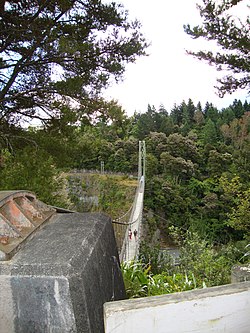Arapuni Suspension Bridge
Arapuni Suspension Bridge | |
|---|---|
 Arapuni Suspension Bridge, with the photo taken from the true right of the Waikato River | |
| Coordinates | 38°04′14″S 175°38′40″E / 38.0706°S 175.6445°E |
| Carries | Pedestrians and cyclists |
| Crosses | Waikato River |
| Locale | South Waikato District |
| Heritage status | – Category II NZHPT – Category II |
| Characteristics | |
| Design | Suspension bridge |
| Material | Steel cables Steel lattice tower Timber deck |
| Total length | 152.4 m |
| Width | 1.57 m (between handrails) |
| No. of spans | One |
| Piers in water | Nil |
| Clearance below | 54 m |
| History | |
| Designer | David Rowell & Co. |
| Constructed by | Armstrong Whitworth |
| Construction start | May 1925 |
| Construction end | 1926 |
| Designated | 21 April 1994 |
| Reference no. | 4168 |
| Location | |
 | |
The Arapuni Suspension Bridge is located just downstream from the Arapuni Power Station on the Waikato River in the South Waikato District of New Zealand. The 152-metre (499 ft) suspension bridge in the bush-lined gorge was built in the mid-1920s to allow workers from the village of Arapuni to access the power station construction site.
History

The bridge spans the Arapuni gorge about 1.5 kilometres (0.93 mi) downstream from the Arapuni Dam. As it was a relatively simple ancillary structure associated with what at the time was New Zealand's largest civil engineering project, the suspension bridge itself received little mention in progress reports and media accounts.[1] Construction started in May 1925 and finished sometime in the three months after April 1926. The bridge does not seem to have had a formal opening function.[1]
The bridge connected "top camp" (which eventually became the Arapuni township) with the western side of the gorge. "Top camp" accommodated the workmen employed on construction of the spillway, powerhouse and penstock.[1]
The bridge was registered a Category II historic place by the Historic Places Trust on 21 April 1994.[1]
Engineering

The bridge was designed by David Rowell & Co. from Westminster, London. The structure is likely to have been shipped prefabricated from England, and was erected by the British contractors for the Arapuni dam and power station project, Armstrong Whitworth.[1] It is one of the longest suspension footbridges in the country.[2] The bridge has a span of 152.4 metres (500 ft)[2] and is 8 metres (26 ft) higher when measured from true left (i.e. the left side when looking downriver) to true right.[3] It has a high steel lattice tower on the true left. On the true right, the bridge footing is cut into the side of the river bank and the foundation for the suspension cables is built on top of the cliff.[2]
Today
The bridge is a popular tourist destination.[4] The site can be accessed via a walkway starting on Arapuni Road opposite Rabone Street.
Bridge users are rewarded with views of the scenic gorge. Geological features can be seen, and the cliffs on the true right of the landing are of volcanic origin and formed by ignimbrite blocks, which are vertically fissured by cooling stresses.[5]
The bridge is sometimes incorrectly called the Arapuni Swing Bridge, for example on signs along the walkway to the bridge. The term 'swing bridge' is in popular use in New Zealand for suspension bridges that act as footbridges.[2]
The Waikato River Trails, which is under construction as part of the New Zealand Cycle Trail, will pass the bridge on the true right of the Waikato River.[6]

References
- ^ a b c d e http://www.historic.org.nz/TheRegister/RegisterSearch/RegisterResults.aspx?RID=4168 Historic Places Trust website on Arapuni Suspension Bridge. Retrieved 16 January 2010
- ^ a b c d Bridging the Gap: Early Bridges in New Zealand 1830 to 1939, pages 4, 208
- ^ http://www.downtown.co.nz/SouthWaikato/Tourism.html Archived 14 May 2010 at the Wayback Machine South Waikato Tourism website on Arapuni bridge. Retrieved 16 January 2010
- ^ "Mighty River Power Generation: About Us: Arapuni". Archived from the original on 27 September 2011. Retrieved 5 May 2009. Mighty River Power website on Arapuni Power Station. Retrieved 16 January 2010
- ^ http://www.southwaikato.com/index.php/discover-the-south-waikato/tourism-and-recreation/arapuni Archived 23 May 2010 at the Wayback Machine Economic Development Group website on Arapuni bridge. Retrieved 16 January 2010
- ^ "Waikato River Trails". Archived from the original on 12 January 2010. Retrieved 16 January 2010. Waikato River Trails website about the Arapuni village to Arapuni dam trail. Retrieved 16 January 2010
External links
- Suspension Bridge Arapuni Suspension Bridge New Zealand Historic Places Trust
- Webarchive template wayback links
- Use New Zealand English from April 2024
- All Wikipedia articles written in New Zealand English
- Use dmy dates from July 2019
- Articles with short description
- Short description is different from Wikidata
- Coordinates on Wikidata
- Infobox mapframe without OSM relation ID on Wikidata
- Pages using infobox bridge with extra embedded table
- Commons category link is on Wikidata
- Suspension bridges in New Zealand
- Heritage New Zealand Category 2 historic places in Waikato
- Bridges completed in 1926
- Bridges over the Waikato River
- Bridges in Waikato
- Tourist attractions in Waikato
- 1926 establishments in New Zealand
- 1920s architecture in New Zealand
- Pages using the Kartographer extension